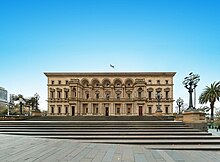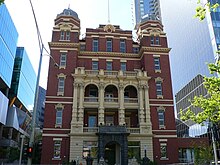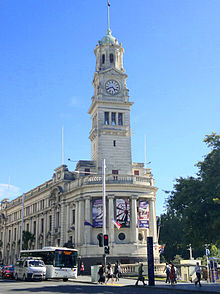John James Clark

John James Clark (23 January 1838 – 25 June 1915) was an Australian architect, who began his career at the age of 14 in the office of the Colonial Architect's Office in Melbourne, immediately after his family migrated from Liverpool in 1852. Clark's 30 years in public service, followed by 33 in private practice, produced some of Australia's most notable public buildings, and at least one in New Zealand.[1] He is most famous as the designer of Melbourne's Old Treasury Building aged only 19.
Biography
John James Clark, commonly referred to as JJ Clark,[2] was born in Liverpool, England, on 23 January 1838 to parents George and Mary Clark. Clark was one of nine children.[3] The family relocated from Liverpool to Melbourne, Australia in March 1852, in hopes of capitalising on the Victorian gold rush.[4] Prior to leaving he had attended Collegiate College, Liverpool,[5] where at thirteen he won first prize for drawing a finely detailed map of Liverpool – every street, all public buildings and the docks.[6] Prior to his father and older brother seeking reward at the gold fields, 14-year-old Clark on the basis of his revealed abilities, was employed on 26 April 1852 as a 'drafting copyist' in the Colonial Architect's Office, ensuring his family an income.[7] It is likely that he was employed and rapidly promoted despite his young age because the office found it hard to keep employees in the throes of the gold rush.[8] To broaden his 'apprenticeship' he sought evening work with the partnership of Alfred Louis Smith and Osgood Gee Pritchard, and for a short time with Joseph Reed. In 1854 he was promoted to draftsman, and in this role was part of the team that designed the Geelong Supreme Court the next year, and Government Printing Office in 1856, and the next year began design work on the Treasury Building when he was only nineteen.[8] While its basement and ground level was being constructed in 1858, he took ten months leave to tour Europe and the United Kingdom, completing the design and overseeing the construction on his return.[9] Clark continued in public service designing many public buildings large and small until 1878 when he was retrenched in the Black Wednesday dismissals.[4]
In 1865 Clark married Mary Taylor Watmuff (1844–1871),[4] who died at the age of 26 in 1871;[10] The couple had one child in 1868, Edward James, known as EJ Clark. In 1870, they had moved into the East Melbourne home Clark had designed for them, which still stands.[11] In 1889 when Edward was 21, Clark took him on a tour of Europe and America, mirroring that of the one he took in his own youth. He followed an artistic interest tutored by noted Colonial artist Louis Buvelot, who became a friend.[8]
In 1880 Clark set up private practice in central Melbourne.[4] Between 1881 and 1896 Clark relocated several times between Victoria, New South Wales, Queensland and Western Australia in pursuit of commissions and employment. One of Clark's most notable achievements, during this time, was his appointment as Queensland Colonial Architect. Results of this work scattered across Australia.
In 1896 Clark and his son formed a professional partnership that lasted until his death,[12] and saw them complete works in Perth, Brisbane, Melbourne and Auckland, New Zealand. Clark died at his sons residence in St Kilda, Melbourne on 25 June 1915.
Clark is the subject of a biography, JJ Clark : architect of the Australian Renaissance by Andrew Dodd, published in 2012 by NewSouth books.[8]
Notable Works
- Old Treasury Building

Old Treasury Building is considered one of the finest examples of Renaissance Revival architecture in Australia. Clark began designing this building in 1857 when he was only nineteen, a widely known fact that still seems remarkable. Construction began in 1858 using bluestone from Broadmeadows for the foundations, and sandstone from Bacchus Marsh for the upper level facades. That year Clark took ten months leave to tour Europe and the United Kingdom, and on his return he completed the design, possibly changing that of the second floor, and removing the fourth level attic of the central section in favour of a continuous eave. The building was finally completed in 1862, but the forecourt was not built until 1868. Originally the Treasury Building was designed to hold Victoria's state gold, as well as offices for senior government positions.[9] In 1874 the Treasury offices were relocated, and the building became known as the Old Treasury, and continued to house offices, including those for the Governor General. In 1992 the building was restored, and from 2005 it was the home of the City Museum.
Treasury Building, Brisbane

Originally known as the New Public Offices, the Treasury Building occupies an entire city block surrounded by Queen Street, George Street, Elizabeth Street and William Street, Brisbane, in Queensland. Built in stages between 1886 and 1928, it is the most impressive public building in Brisbane, and was the seat of the state government public service for much of its life. A design competition in 1883 was won by Melbourne architects Grainger and D'Ebro, but Clark, newly appointed as Queensland colonial architect, argued that the site warranted a larger design, and was commissioned to use his own Italianate design, entered prior to his appointment, as the basis. He resigned from that position in 1885, but the building was completed largely to his design, with arcaded loggias on three sides, and a lively composition of recessed and projecting bays and central pavilions above the cornice.
From 1995 to 2024 the building was occupied by the Treasury Casino and in September 2024, Griffith University announced that they would be purchasing the building, to use as a new inner-city teaching campus.
- Melbourne City Baths

Melbourne City Baths
In 1902, Clark in partnership with his son Edward James won a competition to replace the old Melbourne City Baths, which were completed in 1904.
Considered a significant example of the Edwardian Baroque style, the building uses a bold two tone palette of red brick and cream coloured rendered detailing. The highly articulated facade wraps around the corners of the triangular site, with a lively skyline of numerous domed cupolas, and is a much loved Melbourne landmark.
- Melbourne Hospital

Melbourne (Queen Victoria) Hospital pavilion
In 1910, the partnership of JJ and son EJ were appointed to design the complete replacement of the old Melbourne Hospital, which occupied an entire block in the Melbourne central business district. The design consisted of a series of separate 5 and 6 storey pavilions in red brick Edwardian Baroque style, topped with numerous turrets, linked by walkways, and was completed in 1916. In 1944 the hospital relocated to Parkville, and the Queen Victoria Hospital, established by and for women, occupied the buildings. Closed in 1987, by 1994 all but the central pavilion fronting Lonsdale Street had been demolished. The pavilion became the Queen Victoria Women's Centre, the rest of the block becoming the Queen Victoria Village development.
List of works



Victoria, Melbourne
- 1856 Government Printing Office
- 1858 Old Treasury Building
- 1860 Port Melbourne Court House (originally known as Sandridge Police Court)[13]
- 1869 East Melbourne Residence
- 1869 Richmond Town Hall
- 1871 The Royal Mint
- 1874 Victorian Titles Office
- 1874 Supreme Court
- 1874 Government House
- 1876 The Customs House
- 1880 Essendon and Flemington Institute[14]
- 1903 The City Baths
- 1907 Women's Hospital
- 1907 Carlton Refuge
- 1912 Melbourne Hospital which in 1946 became the Queen Victoria Hospital, Melbourne (partially demolished in 1994)
- - The Port Melbourne Post Office
Victoria, Regional
- 1855 Geelong Customs House
- 1856 Yackandandah Post Office
- 1855 Geelong Supreme Court (demolished)
- 1860 Morse's Creek (Bright) Post Office
- 1862 Sale Court House
- 1863 Newstead Courthouse
- 1863 Kilmore Courthouse
- 1864 Rutherglen Court House
- 1864 Aradale Mental Hospital (as assistant of G. W. Vivian)
- 1874 The Castlemaine Post Office
- 1904 Ballarat National Mutual Building
- - Beechworth Mental Hospital[15]



Queensland
- 1894 Brisbane Children's Hospital
- 1885 Brisbane Treasury Building
- 1885 Townsville Post and Telegraph Office
- 1885 Townsville Hospital
- 1885 Charters Towers Courthouse
- 1885 Mackay Courthouse
- 1885 Kangaroo Point Immigration Centre (Yungaba Immigration Centre)[16][17]
- 1895 The Booroodabin Public Baths
- 1901 Brisbane Central railway station
- 1901 an unexecuted design for the Townsville railway station
- - Gympie Town Hall (first stage)
- - Warwick Town Hall
- - Maryborough railway station
- - Brisbane Masonic Memorial Temple
New South Wales
- 1899 A new scheme for the Newcastle Hospital (of which only the Nurses' Quarters and operating Theatre were built)
- 1903 The Maitland Hospital
- 1862 A unexecuted design for the Sydney Free Public Library[18]
- 1881 The Waverley Town Hall (unexecuted)
- 1881 The Orange Town Hall[19]
- 1880 The Wagga Wagga Town Hall (unexecuted)
Western Australia
- 1897 Perth St Andrew's Presbyterian Church
- 1897 Fremantle Town Hall, alterations and extensions
- 1898 Perth Royal Children's Hospital (unexecuted)
- 1898 Vasse Butter Factory[20]
New Zealand
- 1907 Auckland Town Hall
- - A design for the Auckland Supreme Court
- - A design for a Christchurch Court House
Awards
Clark placed in 38 of the 47 competitions he entered throughout his career; of these, 24 were first placements.[4]
Clark's obituary stated his partnership with son Edward James Clark, became his most professionally successfully period in respect to competition wins with the firm winning in succession competitions for:[12]
- Fremantle Town Hall Auditorium Alterations (Fremantle, 1897)
- Saint Andrew's Presbyterian Church (Perth, 1897)
- Royal Children's Hospital (Perth, 1898)
- Newcastle Hospital (Newcastle, 1899)
- Maitland Hospital (Maitland, 1903)
- The City Baths (Melbourne, 1903)
Additionally in later years the firm successful campaigned for
- National Mutual Building (Ballarat, 1904)
- Women's Hospital (Melbourne, 1907)
- Carlton Refuge (Melbourne, 1907)
- Auckland Town Hall (Auckland, 1907 )
- Melbourne Hospital (Melbourne, 1912)
His other competition awards were produced from individual work, partnerships and associations with architectural firms.
References
- ^ Dodd, Andrew, John James Clark: Public Architect in Australia, unpublished PhD thesis, University of Melbourne 2009.
- ^ "The Conversation – was there an Australian architectural renaissance?". Australian Broadcasting Corporation. 10 May 2012. Archived from the original on 24 July 2012. Retrieved 8 June 2012.
- ^ Clark, Margaret (1993). The Unwin Clark Colonials. Wanneroo, W.A.
{{cite book}}: CS1 maint: location missing publisher (link) - ^ a b c d e "Clark, John James (1838–1915)". Australian Dictionary of Biography. National Centre of Biography, Australian National University. Archived from the original on 10 March 2011. Retrieved 15 April 2010.
- ^ RECORDS OF LIVERPOOL COLLEGIATE SCHOOL | The National Archives
- ^ "Reproduction print of a map of Liverpool, England, drawn by J. J. Clark in 1851, aged 13. Reproduction published by the Royal Historical Society of Victoria from the original in their collection. – No. 86 December 2010".
- ^ "Unknown Genius : News : The University of Melbourne". Archived from the original on 2 April 2010. Retrieved 15 April 2010.
- ^ a b c d "JJ Clark : architect of the Australian Renaissance / Andrew Dodd - Catalogue | National Library of Australia". catalogue.nla.gov.au. Retrieved 11 September 2024.
- ^ a b "City Museum Melbourne". Archived from the original on 24 November 2009. Retrieved 15 April 2010.
- ^ "Family Notices". The Argus. Melbourne. 14 March 1871. p. 4. Retrieved 6 September 2013 – via National Library of Australia.
- ^ "East Melbourne, Gipps Street 104 | East Melbourne Historical Society". emhs.org.au. Retrieved 11 September 2024.
- ^ a b "DEATH OF LEADING ARCHITECT". The Argus. Melbourne. 26 June 1915. p. 16. Retrieved 15 September 2013 – via National Library of Australia.
- ^ "Sandridge Court House". Port Melbourne Historical and Preservation Society. Retrieved 23 August 2023.
- ^ "ESSENDON AND FLEMINGTON INSTITUTE". The Argus (Melbourne). No. 10, 672. Victoria, Australia. 1 September 1880. p. 7. Retrieved 12 September 2024 – via National Library of Australia.
- ^ "J.J.Clark". PocketOz. Retrieved 12 May 2022.
- ^ "Yungaba Immigration Centre (entry 600245)". Queensland Heritage Register. Queensland Heritage Council. Retrieved 15 August 2015.
- ^ "THE NEW IMMIGRATION DEPOT". The Brisbane Courier. 13 July 1887. p. 6. Retrieved 15 August 2015 – via National Library of Australia.
- ^ Dodd, Andrew (1 December 2010). "J. J. Clark: child prodigy architect and his winning but ill-fated design for a Free Public Library in Sydney". State Library Victoria. La Trobe Journal. Retrieved 23 August 2023.
- ^ "ORANGE". The Sydney Morning Herald (NSW : 1842 - 1954). 25 June 1881. Retrieved 23 August 2023.
- ^ "THE VASSE BUTTER FACTORY". The West Australian. Perth. 21 May 1898. p. 2. Retrieved 6 September 2013 – via National Library of Australia.
Further reading
Dodd, Andrew (2012): JJ Clark: Architect of the Australian Renaissance, University of New South Wales Press
Taylor, Florence (12 June 1917). "J.J. Clark: An Architectural Giant", Building, vol 20, no 118, pp 51–66. Retrieved 25 June 2022 – via State Library of Victoria.
External links
- "DEATH OF LEADING ARCHITECT". The Argus. Melbourne. 26 June 1915. p. 16. Retrieved 6 September 2013 – via National Library of Australia.














